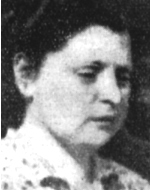Rachel, the daughter of Miriam and Zvi, was born on May 21, 1918 in Lithuania, in the city of Civerti, a small town and a provincial center near the Prussian border, received a religious education and studied Hebrew. Lithuania to the Soviet Union Less than two years later, in June 1941, the Germans occupied Lithuania as part of their war against the Soviet Union, and the riots of the Lithuanians and the persecution of Jews and anyone suspected of communism began, In August 1941 the Jews were transferred to the Kovno ghetto, and in the fall of 1943 the ghetto was converted into a concentration camp Were deported to labor camps in the area and another 2,000 to Estonia, and on March 27, 1944, an Aktion was carried out in which children and elderly were murdered, and on July 8, 1944 the Kovno camp was liquidated and the rest were transferred to Dachau and Stutthof concentration camps. On August 22, 1941, she was transferred to the Kovno ghetto, where she was interned for about three years, and when Rachel was deported, she was caught in a Nazi labor camp. On January 19, 1945, the Soviet Army liberated the camp in which it was staying, near Toren. Upon liberation, Rachel moved to live in a Jewish community on Polish soil. Where she found her way to the Bnei Akiva religious youth movement and began to think about the idea of immigrating to Israel. In Lodz she joined the “Torah V’Avodah” kibbutz, from where she moved to Krakow and to Upper Silesia, began teaching in a Hebrew school and gave lessons to members of the kibbutz. When the Bericha movement began to gather momentum, Rachel joined the wanderers. Some 250,000 Holocaust survivors, mostly from Eastern Europe, left the camp and moved to the DP camps in the West (Germany, Austria and Italy), where they sought to reach ports of departure from which they could sail to Palestine. Rachel passed through Germany and France until she immigrated to Israel from the port of Bacar in Yugoslavia on November 26, 1946 on the “Rafah”. There were 785 immigrants from Eastern Europe on board the ship, which was purchased by the Mossad Le’Aliya Bet for the Haganah in Greece. In the middle of the sea, not far from the shores of the Land of Israel, the ship was caught in a storm, hit a rock and within an hour drowned. Eight of the immigrants perished, the rest swam and found shelter on a deserted beach. A British plane, which emerged three days later, dropped food and equipment, followed by a Greek destroyer to rescue the ship’s crew, followed by British destroyers from the country who brought the illegal immigrants to detention camps in Cyprus. Rachel spent eight months on deportation. She did not cancel her time and served as a teacher for the youth and kibbutz members. But even when she reached the shores of the country again, she could not breathe easily because she was immediately arrested and sent to the Atlit detention camp. A few weeks later, Rachel was released from detention and immediately joined Kfar Etzion, the first Gush Etzion settlement. In a short time she became involved in the group’s life and began to take care of the school children. She even met the man and was about to marry him. According to the United Nations Partition Plan of 29 November 1947, the Etzion bloc was not included in the Jewish state, and immediately after the decision, the Arabs of the area began attacking the communities of the Gush. , And served in the Haganah as part of the “Etzioni” Brigade, the “Jerusalem” Brigade (Division 6.) The Haganah also reinforced the Etzion Bloc in the field fighters from Jerusalem and the religious branch in Tel Aviv In addition to the Palmach fighters from the Harel Brigade. Even before the establishment of the state and LesiDuring the period of the British Mandate, units of the Jordanian army (the Arab Legion) invaded the area and together with the surrounding Arabs attacked the Gush settlements and the roads to them from Jerusalem. During all her days there, Rachel performed various functions with her characteristic quietness and precision, participated in guard duty and was in charge of the paramedics. The decisive attack on the Gush began on May 12, 1948. The next day, on May 13, 1948, the Arab Legion attacked Kfar Etzion in full force, and succeeded in conquering the Yishuv.The village headquarters operated in the building of the German monastery and the Arabs blew up More than 100 of the village’s fighters fell on this day, some were murdered after their surrender, and the next day, on the day of the declaration of the state, the three other settlements in Gush Etzion surrendered and the Gush ceased to exist, Rachel was thirty years old when she fell, and the bodies of the fallen remained in Jordan and their remains were collected in the operation Was dedicated by the military rabbinate in 1949, about a year after the end of the battle, and they were brought to eternal rest in a large mass grave on Mount Herzl in Jerusalem at a state ceremony held on November 17, 1949. The space is ” The last survivors of the Holocaust were survivors of the Holocaust and / or in concentration and hiding camps and / or in hiding and hiding in territories occupied by the Nazis and / or fighting alongside Members of the underground movements or partisans in the Nazi-occupied territories who immigrated to Israel during or after World War II wore uniforms and fell in the Israeli army.
